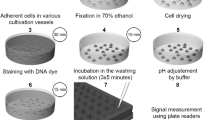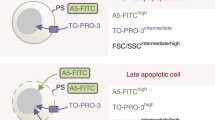Abstract
The phenanthridine dyes propidium iodide (PI) and ethidium bromide (EB) have contributed to make DNA quantitation a routine measurement by flow cytometry. As planar molecules they easily intercalate between base pairs of double stranded nucleic acids. When the quantity of dye exceeds the amount of DNA, the intensity of emitted fluorescence can be related to the amount of DNA. This is, in fact, the basic requirement of quantitative measurement. When staining is performed at low dye concentration and there are no sufficient molecules to saturate all the available DNA-binding sites, the emitted fluorescence, other than the true DNA quantity, may be dependent on the state of chromatin condensation. A staining procedure aimed to stress the influence of nuclear structure on the emitted fluorescence of PI is described. This is achieved by means of a very low dye concentration (<0.01 μg/ml PI) to guarantee staining far below saturation condition. In this particular condition the staining rate slows down to be monitored by flow cytometry. As different experimental models the leucocytes of the normal human peripheral blood have been used taking into account the relatively condensed chromatin of granulocytes with respect to that of the mononuclear cells. Significantly higher fluorescence intensity have been obtained from mononuclear cells compared to that of the polymorphonuclear ones. Quiescent versus exponentially proliferating cell cultures had also been tested. In this staining condition low fluorescence intensity have been obtained by condensed chromatin structure (G0) in comparison to the more decondensed (G1) one.
Similar content being viewed by others
Abbreviations
- PI:
-
propidium iodide
- PBS:
-
phosphate buffered saline
- BrdU:
-
bromodeoxyuridyne
- FCM:
-
flow cytometry
- PMNC:
-
polymorphonuclear cells
- MNC:
-
mononuclear cells
References
Angerer LM, Georghiou S, Moudrianakis EN (1974). Studies on structure of deoxyribonucleoproteins. Spectroscopic characterization of the ethidium bromide binding sites. Biochemistry 13: 1075.
Bolund L, Darzynkiewicz Z, Ringertz NR (1970). Cell concentration and the staining properties of nuclear deoxyribonucleoprotein. Exp Cell res 62: 76–89.
Clausen OAF, Parvinen M, Kirkus B (1982). Stage related variations in DNA fluorescence distribution during rat spermatogenic cycle measured by flow cytometry. Cytometry 2: 421–425.
Cowden RR, Curtis SK (1981). Microfluorimetric investigations of chromatin structure, I: Evaluation of nine DNA-specific fluorochromes as probes of chromatin organization. Histochemistry 72: 11–23.
Crissman HA, Darzynkiewicz Z, Tobey RA, Steinkamp JA (1985). Correlated measurements of DNA, RNA and protein in individual cells by flow cytometry. Science 228: 1321–1324.
Danova M, Riccardi A, Mazzini G (1990). Cell cycle-related proteins and flow cytometry. Haematologica 75: 252–259.
Darzynkiewicz Z (1990). Probing nuclear chromatin by flow cytometry. In: MR Melamed, T Lindmo, ML Mendelsohn (eds), Flow cytometry and sorting, 2nd edn. Wiley-Liss, pp 315–340.
Darzynkiewicz Z, Bolund L, Ringertz NP (1969). Actinomycin D binding of normal and phytohemagglutinin stimulated lymphocytes. Exp Cell Res 55: 120–126.
Darzynkiewicz Z, Traganos F (1990). Multiparametric flow cytometry in studies of the cell cycle. In: MR Melamed, T Lindmo, ML Mendelsohn (eds), Flow cytometry and sorting, 2nd edn. Wiley-Liss, pp 469–501.
Darzynkiewicz Z, Traganos F, Kapuscinski J, Melamed MR (1984). Accessibility of DNA in situ to various fluorochromes. Relationship to chromatin changes during erythroid differentiation of Friend leukemia cells. Cytometry 5: 355–363.
Darzynkiewicz Z, Traganos F, Melamed MR (1980). New cell cycle compartments identified by multiparameter flow cytometry. Cytometry 1: 98–108.
Darzynkiewcz Z, Traganos F, Sharpless T, Melamed MR (1977). Cell cycle related changes in nuclear chromatin of stimulated lymphocytes as measured by flow cytometry. Cancer Res 37: 4635–4640.
Dolbeare F, Gratzner H, Pallavicini M, Gray JW (1988). Flow cytometric measurement of total DNA content and incorporated bromodeoxyuridine. Proc Natl Acad Sci USA 80: 5573–5577.
Evenson DP, Darzynkiewicz Z, Jost L, Janca F, Bellachey B (1985). Changes in accessibility of DNA in situ to various fluorochromes during spermatogenesis. Cytometry 7: 45–53.
Genest D, Sabeur G, Wahl PH, Aubel-Sandron G (1981). Location of the ethidium binding sites of high affinity in chromatin. Biophys Chem 13: 89–95.
Genest D, Sabeur G, Wahl PH, Auchet JC (1981). Fluorescence anisotropy decay of ethidium bound to chromatin. Biophys Chem 13: 77–88.
Kastrup RV, Young MA, Krugh TR (1978). Ethidium bromide complexes with self-complementary deoxytetranucleotides: Demonstration and discussion of sequence preference in the intercalative binding of ethidium bromide. Biochemistry 17: 4855–4864.
Kernell AM, Bolund L, Ringertz NR (1981). Chromatin changes during erythropoiesis. Exp Cell Res 65: 1–6.
Killander D, Rigler RJr (1965). Initial changes of deoxyribonucleic and synthesis of nucleic acids in phytohemagglutinin stimulated human leukocytes in vitro. Exp Cell Res 39: 701–712.
Killander D, Rigler R (1969). Activation of deoxyribonucloprotein in human leukocytes stimulated by phytohemagglutinin. Exp Cell Res 54: 163–170.
Krishan A (1987). Flow cytometric studies on intracellular drug resistance. In: Gray JW, Darzynkiewicz Z (eds), Techniques in cell cycle analysis. Clifton, NJ: Humana Press, pp 337–366.
Krishan A (1987). Effect of drug blockers on vital staining of cellular DNA with Hoechst 33342. Cytometry 8: 642–645.
Larsen JK, Munch-Petersen B, Christiansen J, Jorgensen K (1986). Flow cytometric discrimination of mitotic cells: Resolution of M, as well as G1, S and G2 phase nuclei with mithramycin, propidium iodide, and ethidium bromide after fixation with formaldehyde. Cytometry 7: 54–63.
Liedeman RR, Bolund L (1976). Acridine orange binding to chromatin of individual cells and nuclei under different staining conditions, I: Binding capacity of chromatin. Exp Cell Res 91: 164–174.
Liedeman RR, Matveyeva NP, Vostricova SA, Prilipko LL (1975). Extrinsic factors affecting the binding of acridine orange to the DNP complex of cell nuclei in different physiological states. Exp Cell Res 90: 105–110.
Linden WA, Miller P, Fang SM, et al. (1978). Pulse cytophotometric studies of proliferating (G1) and non-proliferating (G0) cells in vitro and in vivo systems. In: Lutz D (ed), Pulse-cytophotometry III. Ghent: European Press Medikon, pp 275–287.
Mazzini G, Giordano P (1980). Effects of some solvents on the fluorescence intensity of phenantridinic derivatives-DNA complexes: Flow cytofluorometric application. In: Laerum OD, Lindmo T, Thorud E (eds), Flow cytometry, IV. Bergen-Oslo-Trondheim: Universitetsforlaget pp 74–77.
Mazzini G, Giordano P (1981). Flow Cytometry: A methodologic approach for fast quantitative cytochemical measurements and its use for the study of the chromatin structure. Basic Appl Histochem 25: 303–309.
Mazzini G, Giordano P, Montecucco CM, Riccardi A (1980). A rapid cytofluorometric method for quantitative DNA determination on fixed smears. Histochem J 12: 153–168.
Mazzini G, Giordano P, Riccardi A, Montecucco CM (1983). A flow cytometric study of the propidium iodide staining kinetics of human leuccocytes and its relationship with chromatin structure. Cytometry 6: 443–448.
Nicolini C, Belmont A, Parodi S, Lessin S, Abraham S (1979). Mass action and acridine orange staining: static and flow cytofluorometry. J Histochem Cytochem 27: 102–113.
Nicolini C, Kendall F, Baserga R, et al. (1977). The G0/G1 transition of WI38 cells: Laser flow microfluorimetric studies. Exp Cell Res 106: 111–118.
Nolan JP, Posner RG, Martin JC, Habbersett R, Sklar LA (1995). A rapid mix flow cytometer with subsecond kinetic resolution. Cytometry 21: 223–229.
Noronha A, Richman DP (1984). Simultaneous cell surface phenotype and cell cycle analysis of lymphocytes by flow cytometry. J Histochem Cytochem 32: 821–829.
OlmstedIII J, Kearns DR (1977). Mechanism of ethidium bromide fluorescence enhancement on binding to nucleic acids. Biochemistry 16: 3647–3654.
Rabinovitch PS, Torres RM, Engel D (1986). Simultaneous cell cycle analysis and two-color surface immunofluorescence using 7-amino-actinomycin D and single laser excitation: Applications to study cell activation and the cell cycle of murine ly-1 b cells. J Immunol 136: 2769–2775.
Reinhardt C, Krugh TR (1978). A comparative study of ethidium bromide complexes with dinucleotides and DNA: Direct evidence for intercalation and nucleic acid sequence preferences. Biochemistry 17: 4845–4854.
Riccardi A, Danova M, Wilson G, et al. (1988). Cell kinetics in human malignancies studied with in vivo administration of bromodeoxyuridine and flow cytometry. Cancer Res 48: 6238–6245.
Rigler RJr (1966). Microfluorimetric characterization of intranuclear nucleic acids and nucleoproteins by acridine orange. Acta Physiol Scand 67 (suppl 267): 1–122.
Ringertz NR, Bolund L, Darzynkiewicz Z (1970). AO binding of intracellular nucleic acids in fixed cells in relation to cell growth. Exp Cell Res 63: 233–238.
Sandhu CL, Warters RL, Dethlefsen LA (1985). Fluorescence studies of Hoechst 33342 with supercoiled and relaxed plasmid pBR322 DNA. Cytometry 6: 191–194.
Smets LA (1973). Activation of nuclear chromatin and the release from contact-inhibition of 3T3 cells. Exp Cell Res 79: 239–243.
Stokke T, Steen HB (1976). Binding of Hoechst 33258 to chromatin in situ. Cytometry 7: 227–234.
Stokke T, Steen HB (1987). Distinction of leukocyte classes based on chromatin-structure-dependent DNA binding of 7-aminoactinomycin D. Cytometry 8: 576–583.
Traganos F, Gorski AJ, Darzynkiewicz Z, Sharpless T, Melamed MR (1977). Rapid multiparameter analysis of cell stimulation in mixed lymphocyte culture reactions. J Histochem Cytochem 25: 881–887.
Wang E Krueger JG (1985). Application of a unique monoclonal antibody as a marker for non-proliferating sub-population of cells of some tissues. J Histochem Cytochem 33: 587–594.
Wilson GD, McNally KJ, Dunphy E, Karker H, Pfagner R (1985). The labelling index of human and mouse tumour assessed by bromodeoxyuridine staining in vivo and in vitro, and flow cytometry. Cytometry 56: 641–648.
Author information
Authors and Affiliations
Rights and permissions
About this article
Cite this article
Mazzini, G., Alberici, R., Melchioni, C. et al. Flow cytometry and staining kinetics to monitor the G0/G1 transition. Methods Cell Sci 18, 165–177 (1996). https://doi.org/10.1007/BF00122167
Issue Date:
DOI: https://doi.org/10.1007/BF00122167




